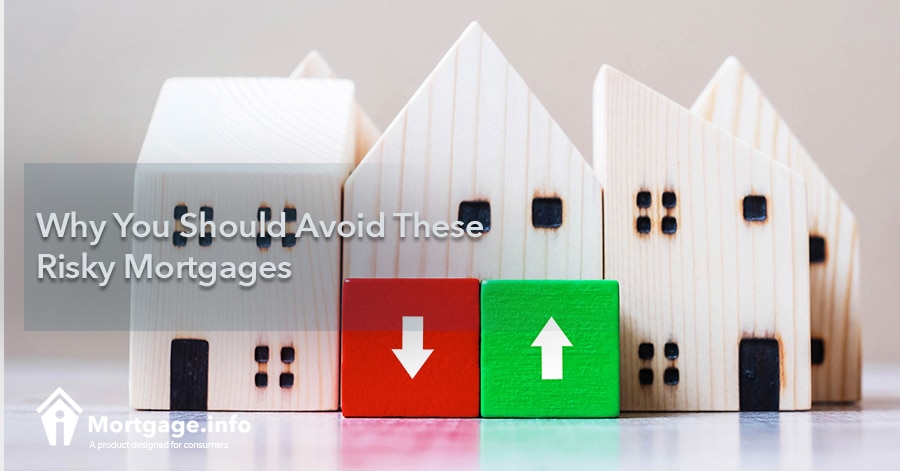Many people need a mortgage if they want to buy a home. Unfortunately, mortgages are not a one-size-fits-all approach. Some borrowers need specific features in order to qualify. However, some of those features may be considered ‘risky.’ Are they too risky for you?
Get Matched with a Lender, Click Here.
Keep reading to learn which mortgages we think you should avoid moving forward.
Extended Term Mortgages Have High Risk
The average borrower has a 30-year mortgage and that’s about as far as you should stretch it. Stretching your mortgage term out too long just ends up costing you more in the end. Many borrowers focus strictly on the monthly payment. They determine what they can afford now and tailor their term accordingly. While that’s a great way to stay financially stable, it’s not always the best choice. You have to look at the big picture.
What we mean is you have to see what the loan costs in its entirety. Your mortgage lender gives you an amortization schedule for a reason. If they don’t, ask how much interest you’ll pay over the life of the loan. You should also ask for a 30-year loan estimate so you can compare the two. For example, let’s look at a $100,000 loan for 30 and 40 years.
- 30-year loan – You would pay $477.42 in principal and interest and $71,869 in interest over the entire life of the loan
- 40-year loan – You would pay $417.94 in principal and interest and $100,610 in interest over the entire life of the loan
This means a 40-year term would cost you $28,741 more just to stretch the term out. We recommend taking a smaller mortgage rather than taking the longer term. This may mean buying a smaller house, but it fits within your financial parameters.
Interest Only Loans are Risky
Interest only loans are less common today, but they still exist. The most common programs charge you interest only for the first few years of the term. Typically, you pay the interest for the first five or ten years. This will reduce how much you owe during that time. However, when the principal payments become due, you can go into payment shock.
Click to See the Latest Mortgage Rates.
The principal you will owe is amortized over the remaining years in the term. Let’s say, for example, you have a 10-year interest only loan. That means you pay interest only for 10 years and only have 20 years to pay off the principal. That will make a significant difference in the principal payment you must make.
If you are in a profession that you know your income will increase without a doubt, this could be a good option. If you are not and you think you may still be in the home, in the long run, this probably isn’t the best mortgage option for you.
Adjustable Rate Mortgages Pose a Risk
ARM loans are still common even after the housing crisis. They aren’t the riskiest loans on the market, but they definitely have a certain level of risk. With this loan program, you only get a fixed rate for a short period of time. Granted, during that time, your rate is pretty low and sometimes even lower than fixed-rate mortgages allow. But, you have no way to predict how high the rate will go after it adjusts.
The ARM program you have will determine how often the rate adjusts. Most ARM loans have a rate that adjusts annually, though. This could mean that the rate adjusts up or down, though. You may get lucky and get a lower rate for a year, but you won’t know where you’ll stand from year to year.
If you cannot handle that type of certainty or don’t have the ability to handle a rising payment, an ARM can be a very risky loan type for you.
Low Down Payment Loans can be Risky
Some, but not all, low down payment loans are risky. For example, FHA and VA loans are both low down payment options. FHA loans require just 3.5% down and VA loans don’t require a down payment in most cases. Many subprime loans allow little to no down payment options as well.
It’s not necessarily the low down payment that is the risk here; it’s the home’s value. You cannot predict how the market will react, as the housing crisis showed. If the market takes a dive again, you could end up upside down on your home. If you plan to live there for the long-term, it may not be a horrible thing. But, if this isn’t your forever home, it may just become that or force you to take a loss.
Before you take a low down payment loan really consider your options. Do you have more money to put down on it? Is it an area that appreciates? Look at the historical figures, including how the area reacted to the housing crisis. This way you can somewhat predict what may happen to you if you the house does depreciate.
The right mortgage for you is the one that fits your needs. You cannot base your decision on anything but your personal factors. If you consider any of the above risky programs, though, make sure you understand the consequences. If you do have to take a 40-year term or an ARM, for example, try to make it a short-term thing. If you can refinance out of it in the near future, you eliminate some of the risks of the loan.

